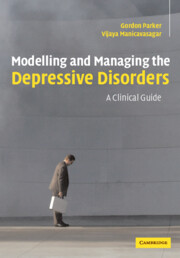Book contents
- Frontmatter
- Contents
- Acknowledgements
- Introduction
- Part I The current model for depressive disorders and its impact on clinical management
- Part II The diagnosis and management of melancholic and psychotic depression
- Part III An introduction to non-melancholic depression
- Part IV Modelling and managing the non-melancholic depressive disorders
- 13 Acute stress-related non-melancholic depression
- 14 Acute stress-related non-melancholic depression: ‘key and lock’ model
- 15 Chronic stress-related non-melancholic depression
- 16 The perfectionist personality style and non-melancholic depression
- 17 Irritability and non-melancholic depression
- 18 Anxious worrying and non-melancholic depression
- 19 Social avoidance and non-melancholic depression
- 20 Personal reserve and non-melancholic depression
- 21 Rejection sensitivity and non-melancholic depression
- 22 Self-focused personality style and non-melancholic depression
- 23 Self-criticism and non-melancholic depression
- 24 Natural and alternative treatments for non-melancholic depression
- Appendix 1 The DMI-18 and the DMI-10
- Appendix 2 The CORE system of measuring psychomotor disturbance
- Appendix 3 The temperament and personality measure
- References
- Index
15 - Chronic stress-related non-melancholic depression
from Part IV - Modelling and managing the non-melancholic depressive disorders
Published online by Cambridge University Press: 17 August 2009
- Frontmatter
- Contents
- Acknowledgements
- Introduction
- Part I The current model for depressive disorders and its impact on clinical management
- Part II The diagnosis and management of melancholic and psychotic depression
- Part III An introduction to non-melancholic depression
- Part IV Modelling and managing the non-melancholic depressive disorders
- 13 Acute stress-related non-melancholic depression
- 14 Acute stress-related non-melancholic depression: ‘key and lock’ model
- 15 Chronic stress-related non-melancholic depression
- 16 The perfectionist personality style and non-melancholic depression
- 17 Irritability and non-melancholic depression
- 18 Anxious worrying and non-melancholic depression
- 19 Social avoidance and non-melancholic depression
- 20 Personal reserve and non-melancholic depression
- 21 Rejection sensitivity and non-melancholic depression
- 22 Self-focused personality style and non-melancholic depression
- 23 Self-criticism and non-melancholic depression
- 24 Natural and alternative treatments for non-melancholic depression
- Appendix 1 The DMI-18 and the DMI-10
- Appendix 2 The CORE system of measuring psychomotor disturbance
- Appendix 3 The temperament and personality measure
- References
- Index
Summary
Exposure to one or more uncontrollable stressors over an extended period of time can be associated with the development of non-melancholic depression. These stressors include chronic psychosocial adversity, physical illness, or exposure to recurrent psychological abuse and trauma. Unremitting and adverse life events can test the mettle of the most resilient individuals and exhaust their ability to adapt and cope.
At times, chronic stress-related depression may occur within the context of a history of early developmental deprivation. People who have had the misfortune to be exposed to early adversity may develop an expectation of further hardship and a pessimistic world view. Due to their long-standing experiences with uncontrollable and overwhelming stressors, such individuals may not have learnt effective problem-solving strategies to control or minimise the effects of future stressors.
The psychotransmitter model
Chronic and multiple salient and non-salient life events stimulate the production of large amounts of psychotransmitter which bombards the postsynaptic neuron and binds to receptor sites. Ion channels (perceptual and attributional biases) are stimulated to remain open, thus allowing the unremitting passage of ions into the neuron which, in turn, sets off numerous metabolic processes within the cell. Consequently, the neuron reacts to an unrelenting source of chronic stimulation and is flooded by the effects of high concentrations of intracellular chemical mediators (coping repertoires).
- Type
- Chapter
- Information
- Modelling and Managing the Depressive DisordersA Clinical Guide, pp. 123 - 130Publisher: Cambridge University PressPrint publication year: 2005



